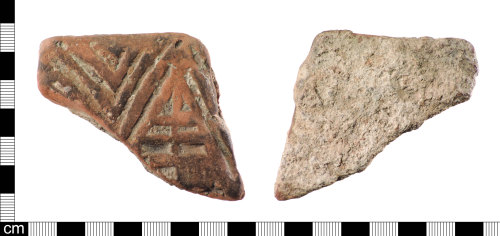
Rights Holder: The Portable Antiquities Scheme
CC License: ![]()
Image use policy
Our images can be used under a CC BY attribution licence (unless stated otherwise).
TILE
Unique ID: LON-53E874
Object type certainty: Certain
Workflow
status: Awaiting validation ![]()
An incomplete Roman ceramic Lowther's Group 1 and Betts Die 58, relief-patterned flue-tile dating from AD 150-200. A similar tile is illustrated in Betts et al (1997:53 Fig.27a). The front is decorated with relief-patterned rolled design in the "W. Chevron" group style. Betts writes "Keyed with wooden rollers applied when the clay was still damp, before they were put into the kiln to fire. This was added so the tiles could be more firmly mortared into place." The fabric is fully oxidised and red throughout. Betts et al (1997:120) write " Context dating: at Winchester Palace example 11 was found in the demolition debris of Building 14 which has a terminus post quem of AD 150-250 and was demolished c 287 or later (B. Yule pers. comm.). Circumstantial dating: the earliest phase of the bath-suite at Pudding Lane (example 3) is dated mid 2 cent, and this may have been altered to a different use early in the third cent., again becoming a bath-suite after AD 370 (Milne 1985, 139-41). The similarity between the designs of dies 35 and 58, and a re-cut seems possible. If this was the case, since the pattern of die 58 is longer than that of die 35, die 58 will have been the earlier die."
McComish (2015:12) writes "Box flues (tubuli) are hollow rectangular or square cross-sectioned tiles, with sanded interior surfaces, and they have vents in two opposing sides, while the other two sides are usually keyed. The keying can be incised, finger drawn, combed, or relief-patterned. There is no standard size for box flue tiles nationally (ibid., 74). Box flues were made by wrapping a slab of clay around a sanded former then joining the edges of the clay together with a single seam, and the vents were cut out after the tile was removed from the former (Rudling et al. 1986, 204)."
Dimensions: length: 66.97mm; width: 61.29mm; thickness: 18.18mm; weight: 71.82g.
Betts et al (1997:52) write "London still has the biggest concentration of individual examples and different die patterns, and it is the tile kilns located near London, such as Ashtead, Surry, Brockley Hill, Middlesex and Potters Bar, Hertfordshire, which probably formed the chief production centres for the manufacture of relief-patterned tile in south-east England."
Other box flue-tiles on the database are LON-E4384A, LON-6D895E, PUBLIC-29D515 and LON-1582B3.
Reference: Betts I., Black E. W.A and Gower J. 1997. Journal of Roman Pottery Studies Vol. 7. Corpus of Relief-Patterned Tiles in Roman Britain. Oxbow books, Oxford
McComish J.M., 2015. A Guide to Ceramic Building Materials. Report Number 2015/36, York Archaeological Trust.
Class:
Relief-Patterned Flue-Tile
Sub class: Lowther Group 1 "W. Chevron", Betts Die 58
Subsequent actions
Subsequent action after recording: Returned to finder
Chronology
Broad period: ROMAN
Subperiod from: Early
Period from: ROMAN
Subperiod to: Late
Period to: ROMAN
Date from: Circa AD 150
Date to: Circa AD 200
Dimensions and weight
Quantity: 1
Length: 66.97 mm
Width: 61.29 mm
Thickness: 18.18 mm
Weight: 71.82 g
Personal details
This information is restricted for your access level.
Materials and construction
Primary material: Ceramic
Manufacture method: Hand made
Completeness: Fragment
Spatial metadata
Region: London (European Region)County or Unitary authority: Greater London Authority (Greater London Authority)
District: City and County of the City of London (London Borough)
Parish or ward: Billingsgate (London Borough Ward)
Spatial coordinates
4 Figure: TQ3380
Four figure Latitude: 51.50329348
Four figure longitude: -0.08515568
1:25K map: TQ3380
1:10K map: TQ38SW
Grid reference source: Generated from computer mapping software
Unmasked grid reference accurate to a 1 metre square.
References cited
No references cited so far.
Similar objects

Find number: LON-485D38
Object type: TILE
Broadperiod: ROMAN
A ceramic Roman Lowther's Group 4 and Betts Die 10, relief-patterned flue-tile dating from AD 150-200. A similar tile is illustrated in Betts…
Workflow: Awaiting validation![]()

Find number: PUBLIC-A61074
Object type: TILE
Broadperiod: ROMAN
A ceramic Roman Lowther's Group 5 and Betts Die 12, relief-patterned flue-tile fragment, dating AD 150-AD 200. A similar tile is illustrated…
Workflow: Awaiting validation![]()

Find number: LON-9C8A61
Object type: TILE
Broadperiod: ROMAN
An incomplete Roman ceramic Lowther's Group 1 and Betts Die 3, relief-patterned flue-tile dating from AD 150-200. A similar tile is illustrat…
Workflow: Awaiting validation![]()


